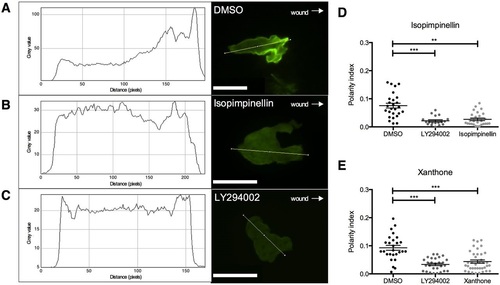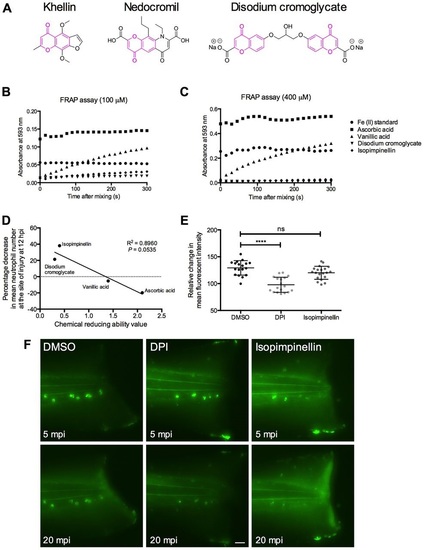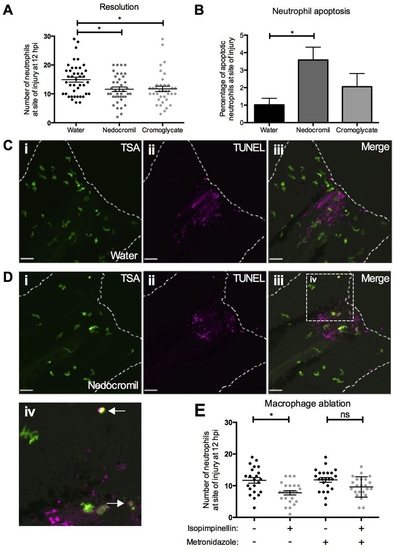- Title
-
Identification of benzopyrone as a common structural feature in compounds with anti-inflammatory activity in a zebrafish phenotypic screen
- Authors
- Robertson, A.L., Ogryzko, N.V., Henry, K.M., Loynes, C.A., Foulkes, M.J., Meloni, M.M., Wang, X., Ford, C., Jackson, M., Ingham, P.W., Wilson, H.L., Farrow, S.N., Solari, R., Flower, R.J., Jones, S., Whyte, M.K., Renshaw, S.A.
- Source
- Full text @ Dis. Model. Mech.
|
Isopimpinellin and xanthone inhibit polarisation of neutrophils upstream of PI3K. Assay to measure the polarity index of neutrophils in Tg(lyz:PHAkt-EGFP) larvae pretreated with 25µM isopimpinellin, 25µM xanthone, 50µM LY294002 or DMSO as a vehicle control for 2h prior to tail-fin injury. Representative images of individual neutrophils in the region between the wound site and posterior blood island illustrate polarisation and a defined leading edge of a migrating neutrophil in (A) DMSO control-treated larvae, compared to (B) isopimpinellin- and (C) LY294002-treated larvae, which do not polarise or have a defined leading edge (scale bars: 11µm). Arrows indicate direction of wound. Fluorescence (referred to as grey value) was measured in a transection of each neutrophil (the yellow lines drawn through the cells) to generate intensity profiles shown in the panels on the left and quantify neutrophil polarity index as previously described (Wang et al., 2014). Both (D) isopimpinellin and (E) xanthone reduced the neutrophil polarity index to a similar level as the known PI3K inhibitor LY294002 (one-way ANOVA with Dunnett′s multiple-comparison post-test; **P<0.01, ***P<0.001; n=27, performed as three independent experiments). EXPRESSION / LABELING:
PHENOTYPE:
|
|
Isopimpinellin accelerates inflammation resolution in vivo by inducing neutrophil apoptosis. (A) Inflammation resolution assay in mpx:GFP larvae treated with varying doses of isopimpinellin at 6hpi. Isopimpinellin significantly reduces neutrophil numbers at the wound at 12hpi in a dose-dependent manner (one-way ANOVA with Dunnett′s multiple-comparison post-test; **P<0.01, ***P<0.001; n=18, performed as three independent experiments). Dotted line at y=18.5 indicates mean neutrophil number at wound in DMSO control larvae. (B) Total neutrophil number measured in mpx:GFP larvae treated with DMSO or 25µM isopimpinellin for 24h. Isopimpinellin did not affect total neutrophil number (unpaired t-test; P=0.8696; n=18, performed as three independent experiments). (C) Reverse-migration assay in mpx/Kaede larvae treated with DMSO or 25µM isopimpinellin from 4hpi. Neutrophils at the site of injury were photoconverted at 6hpi and the numbers of photoconverted cells that moved away from the wound were quantified over 5h. Neutrophils migrated away from the wound at a slower rate in isopimpinellin-treated larvae compared to DMSO control larvae. (D) Representative image of isopimpinellin-treated mpx/Kaede larvae at 8hpi (scale bar: 70µm). Solid white line in the left panel indicates the outline of the tail-fin, and the boxed area is magnified in the right-hand panel. White arrows in magnified view indicate neutrophils that appear apoptotic. (E,F) FRET assay in Tg(mpx:FRET)sh237 larvae treated with DMSO or 25µM isopimpinellin from 4hpi and imaged from 6hpi. Cleavage of the caspase-3 target site results in separation of the fluorophores and loss of the FRET signal (red, F). Acceptor (neutrophil) fluorescence (green, F) persists for a further 10-20min before cell death and loss of fluorophore integrity. Time is shown as hours:minutes. Scale bar: 50µm. Number of observable apoptotic events was increased in isopimpinellin larvae (unpaired t-test; ***P<0.001; n=18, performed as three independent experiments). (G) TUNEL assay in mpx:GFP larvae treated with DMSO or 25µM isopimpinellin from 6hpi and fixed at 12hpi. Numbers of TSA-positive neutrophils and TSA/TUNEL double-positive apoptotic neutrophils at the site of injury were measured to calculate percentage neutrophil apoptosis, which was increased in isopimpinellin-treated larvae (unpaired t-test; ***P<0.001; n=115, performed as two independent experiments). (H) Larvae were treated with DMSO, 100µM Z-VAD-FMK (zVAD), 25µM isopimpinellin (Iso) or in combination (Iso+zVAD) from 4hpi and imaged from 6hpi. Number of observable apoptotic events was increased with isopimpinellin alone but the effect was lost with the addition of Z-VAD-FMK (one-way ANOVA with Bonferroni′s multiple-comparison post-test to compare selected columns; *P<0.05; ns, non-significant; n=14, performed as three independent experiments). (I) Larvae were treated with DMSO, 20µM roscovitine or 50µM pyocyanin from 4hpi and imaged from 6hpi. Number of observable apoptotic events was increased with pyocyanin (one-way ANOVA with Bonferroni′s multiple-comparison post-test to compare selected columns; *P<0.05; n=18, performed as three independent experiments). EXPRESSION / LABELING:
PHENOTYPE:
|
|
Isopimpinellin and disodium cromoglycate do not have antioxidant activity. (A) Isopimpinellin is a structural isomer of khellin, from which a series of functional benzopyrone analogues were designed, including disodium cromoglycate and nedocromil. (B,C) FRAP assay, performed at 37°C for 5min. Graphs show the rate of increase in absorbance at 593nm, corrected for reagent blank readings, at (B) 100µM and (C) 400µM of each compound, as indicated. (D) The in vivo activity of the compounds tested (expressed as the percentage decrease in the mean neutrophil numbers at the wound at 12hpi), in comparison to the vehicle control (refers to data from Figs 3A, 6A and Fig. S3), plotted against the chemical reducing ability value (refers to data from Table S1) (linear regression analysis; R2=0.8960; P=0.535). (E) In vivo antioxidation assay. Larvae were pretreated with DMSO, isopimpinellin or DPI for 2h and pentafluorobenzenesulfonyl fluorescein for 1h prior to tail-fin injury. Imaging commenced 5min post-injury (mpi) and mean fluorescence intensity at the injury site was measured at 5 and 20mpi. Mean fluorescent intensity at 20mpi is expressed as a percentage of the mean fluorescent intensity at 5mpi. This was significantly reduced by DPI but isopimpinellin had no effect (one-way ANOVA with Dunnett′s multiple-comparison post-test; ****P<0.0001; ns, non-significant; n>15, performed as two independent experiments). Illustrative images are shown in F. Scale bar: 50 µm. |
|
Clinical cromones promote neutrophil apoptosis to drive inflammation resolution in vivo. (A) Inflammation-resolution assay in mpx:GFP larvae injected with 0.4pg/µl nedocromil or 0.5pg/µl disodium cromoglycate at 6hpi. Both compounds significantly reduce neutrophil numbers at the wound at 12hpi compared to the water control (one-way ANOVA with Dunnett′s multiple-comparison post-test; *P<0.5; n>36, performed as four independent experiments). (B-D) TUNEL assay in mpx:GFP larvae injected with water, 0.4pg/µl nedocromil or 0.5pg/µl disodium cromoglycate from 6hpi and fixed at 12hpi. Numbers of TSA-positive neutrophils and TSA/TUNEL double-positive apoptotic neutrophils at the site of injury were measured to calculate percentage neutrophil apoptosis, which was increased in nedocromil-treated larvae (one-way ANOVA with Dunnett′s multiple-comparison post-test; *P<0.05; n>54, performed as three independent experiments). (C,D) Illustrative images of water-injected (C) and nedocromil-injected (D) larvae following TSA/TUNEL staining (scale bars: 40µm). Broken lines indicate the outline of the tail-fin. White arrows in magnified view of boxed area in Diii (Div) indicate apoptotic neutrophils, identified by morphology and double TSA/TUNEL labelling. (E) Inflammation-resolution assay in the absence of macrophages. Metronidazole ablation of macrophages impairs the effect of isopimpinellin (one-way ANOVA with Bonferroni′s multiple-comparison post-test to compare selected columns; *P<0.05; ns, non-significant; n>20; performed as three independent experiments). EXPRESSION / LABELING:
PHENOTYPE:
|




